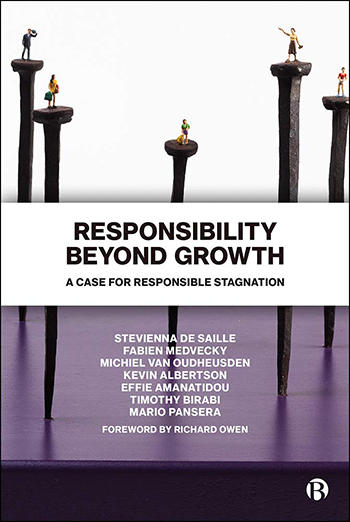Responsibility Beyond Growth. A Case For Responsible Stagnation by Stevienna de Saille, Fabien Medvecky, Michiel van Oudheusden, Kevin Albertson, Effie Amanatidou, Timothy Birabi and Mario Pansera has just been released by Bristol University Press.
The book opens with a foreword from Richard Owen, in which he offers a succinct overview of the ideas that permeate the book, before a preface describes the practicalities of how the book was developed and written, signed in the name of the Fourth Quadrant Research Network. The fourth quadrant (that of responsible stagnation) appears in a figure with quadrants representing responsibility, irresponsibility, innovation and stagnation. The preface also addresses the COVID-19 reality that we find ourselves living in today, with its dramatic economic and social effects.
As the book develops however the common-sense link between forced economic shrinkage and the authors’ aims of analyzing the relationship between innovation and economy becomes clearer and more distinct.
I personally feel that the phrase Responsible Stagnation leads to a certain type of common-sense interpretation that does not fully reflect the book’s approach. Stagnation brings feelings of hopelessness, of poverty and neglect, as that is how it is used in everyday language. But the authors point out that the global economy has been in a state of stagnation for decades, so they are proposing a form of responsibility that is situated within a realistic interpretation of the economic situation, rather than one that aims at dragging a sluggish world out of stagnation and into growth.
The authors are not necessarily proposing a de-growth model, but a-growth, something they describe as growth agnosticism.
The book is raising the issue of the aim of innovation, rather than the process, as the aim creates the framework that the innovation system is itself constituted by. The authors question what an innovation policy misses if its aim is economic growth as measured by GDP, using the example of the EU funding of their own concept of Responsible Research and Innovation as the starting point for their argument.
A simple question can make this relationship clear: Can an innovation be responsible if it doesn’t work towards the aim of promoting economic growth? The uncomfortable answer might be that such a valuation just depends on who funded the innovation process.
The publication can be seen as a sort of Tractatus. Rather than containing a narrative argument, it offers an array of ideas from different and varied perspectives. Each chapter being singularly or group written but based on common understandings, the authors offer their own perspectives on a joint project, not describing a phenomenon as such but rather investigating what such phenomena might be, and even what the implications of their investigation might be.
Three main questions are addressed: How do we innovate responsibly in secularly stagnant economies? Is it possible to take an a-growth approach to innovation? Under what circumstances might this constitute a crucial part of the RI matrix described in the book (with a fourth quadrant as described above)?
Several case study examples of real-life approaches are described (Part 3), and it is at this point that the political and environmental practicalities become much clearer, reflecting the book’s grounding in a concrete interpretation of the economic reality we inhabit today.
This book is aimed at a broad readership and does not require prior RI, RRI or economic training. It’s easy to read and understand, jargon-free and above all clear and thought provoking. The book overall is collectively authored, but each chapter reflects the specific expertise of the author(s) assigned to it, adding a variety that draws the reader in, all of which makes it an enjoyable read that I would fully recommend.
Responsibility Beyond Growth. A Case for Responsible Stagnation by Stevienna de Saille, Fabien Medvecky, Michiel van Oudheusden, Kevin Albertson, Effie Amanatidou, Timothy Birabi and Mario Pansera, is published by Bristol, Bristol University Press, 2020, pp.168, and costs €19.99 (hardback) ISBN 978-1529208177

——————-
















